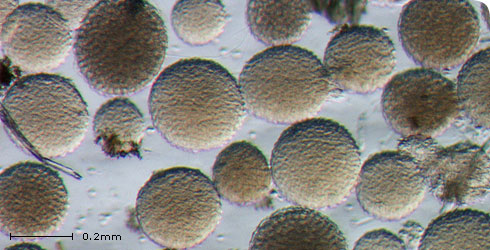Biology
Little is known about the biology of this parasite and its life-cycle has only recently been resolved. Surprisingly, the Myxozoa have recently been shown to be highly reduced animals that are most closely related to cnidarians (jellyfish, hydras and corals) (Jiménez-Guri et al. 2007).
Size
T. bryosalmonae develops into tiny, sac-like stages around 0.35mm in diameter in the body cavity of freshwater bryozoans. Each sac contains 1000’s of infectious stages (spores). Parasite stages in fish consist of only several cells.
Growth
Laboratory studies indicate that sac-like stages can develop within 3 days from single cell stages in bryozoan hosts (Canning & Okamura, 2004). Transmission studies demonstrate that it takes some 3-8 weeks from the time of infection for stages to develop in fish kidney, depending on temperature (Gay et al. 2001).
Life expectancy
Long term infections of bryozoans appear to be maintained by:
- low virulence (Tops et al. 2009)
- host-condition dependent cycling between covert and overt infections (Tops et al. 2006; 2009)
- transmission of infection to new colonies by colony fragmentation (Morris and Adams, 2006) and possibly via bryozoan resting stages (statoblasts) (Hill and Okamura, 2007)
When fish survive infection the parasite may persist for at least one year (Foott and Hedrick, 1987), and perhaps for the lifetime of the fish. Spores are infective for <24 hr (De Kinkelin et al. 2002 ).
-

Reproduction and dispersal
Find out about the reproductive patterns of Tetracapsuloides bryosalmonae and discover its dispersal strategies.
-

Lifecycle
Learn about the various stages of the lifecycle of this species.
